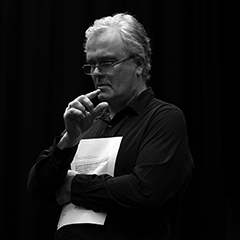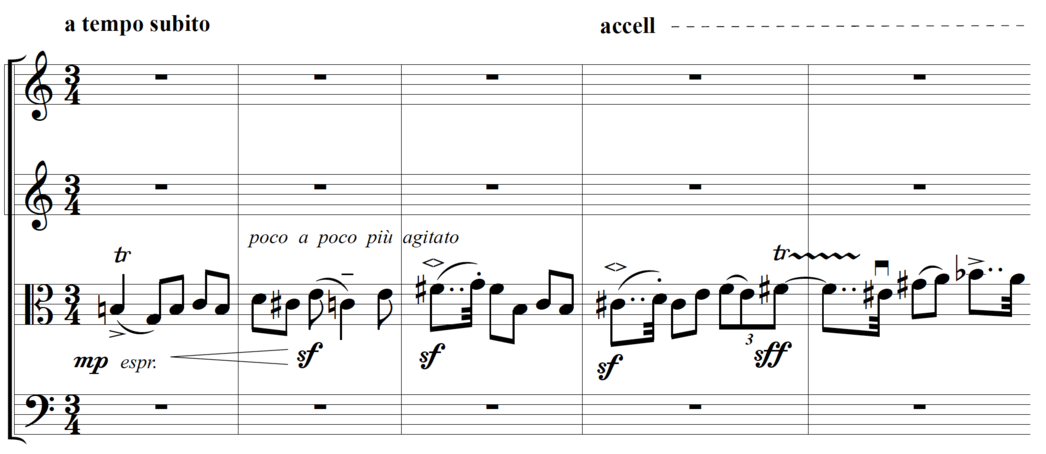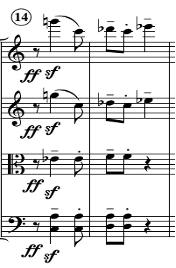FURTHER READING ABOUT THE PROJECT
Taking a Fresh Look at Harald Sæverud’s 2nd and 3rd String Quartets
by Ricardo Odriozola
The process of working with students
The decision to work on Sæverud's very complex music with students, rather than with professionals, was made for two reasons. The first one is extremely prosaic: economy. The second reason was to keep the process fresh; Ricardo Odriozola (RO), who had earlier played the first violin part in many concerts and on a CD recording, decided to change perspective and relearn the music on the viola. Then he relearned the music together with a group of musicians who had had no prior experience with Sæverud's music. RO believed that students are far more open-minded towards unknown music than professional musicians at times can be. The wholly positive experience of working with the three remarkable students gave credence to this view. They were patient to a fault. It took time before the players arrived at a consensus of sorts about the sound-world the music inhabited. It was like learning a new language or a very obscure dialect of a known language.
Odriozola's methodological approach was twofold:
-
performance aspects
-
editorial work
Regarding performance, he rehearsed the works in their separate movements, performing these along the way at different venues including the workshops and seminars of the artistic research group. The working sessions were painstaking “deep dives” into the intricacies of the music (at first chiefly technical aspects), exploring the possibilities it offered in all areas: articulation of individual pitches and form, texture, and expression. The final, complete performances of each work took place at the end of the academic year and at the most problematic of all the venues - the Grieghallen foyer.
During editorial work, questions about the ambiguities of the text were raised and discussed with the players and the artistic research group. The extant manuscripts at the Bergen Public Library and the National Library in Oslo were consulted regarding both works. A significant interview was conducted with Rolf Sandvik, who had premiered both works on the first violin in the 1970s.
At first RO guided the students through the peculiarities of Sæverud's style. Gradually and especially during the second year, the students adopted a more active role, coming up with suggestions and solutions of their own. The most remarkable moment in the process occurred during the first reading rehearsal of the second quartet after summer break. Naturally not all the notes were in place, but the Sæverud style had been assimilated. It was a turning point.
Had the work with the students provided RO with plenty of material to discuss the horrors and tribulations of working on very difficult music with a group of inexperienced players, it might have made interesting documentation here. Happily (or regrettably?) this was not the case. Although the Grieg Academy string students selected for the project lacked earlier experience with Sæverud's music, they more than compensated for this with skills and accomplishments of their own. Despite technical and interpretational difficulties with Sæverud’s string quartets, the students showed an admirable openness, respect, and team spirit during the entire working process.
Here are some examples of passages which the players found particularly demanding:
- See illustration 1: “String Quartet No. 2”, 1st movement, rehearsal No. 6, cello -
See illustration 2: “String Quartet No. 2”, 1st movement, 5 measures after rehearsal No. 20, viola -
See illustration 3: “String Quartet No. 2”, 2nd movement, 7 mm. before reh. No. 6, violins in unison –
See illustration 4: “String Quartet No. 2”, 3rd movement, reh. No. 12, 1st violin -
See illustration 5: “String Quartet No. 2”, 4th movement, 3 mm. before reh. No. 1, 1st violin –
See illustration 6: “String Quartet No. 3”, 1st movement, reh. No. 15 (cello) –
In order to understand the experiences of the younger players in the group, please read the master project paper written in spring 2019 by violinist Vladimira Ščigulinská and cellist Carmen Bóveda, “String Quartet No. 2” Op. 52 by Harald Sæverud.
See link: PAPER Carmen and Vladimira’s paper
Reflections on relevant sources on the composer and his music
Sæverud's music is seldom performed, even less so after his death. Thus, there is a lack of properly established performance practice for his music, as opposed to the music of contemporaries such as Bartók, Stravinsky or Shostakovich. There are several valuable sources in quest for a better understanding of Sæverud's music:
-
Books written by people who knew the composer (Lorentz Reitan, Jan Henrik Kayser)
-
Texts written by Sæverud himself
-
Recordings made in the presence of the composer
-
Recordings made by artists who knew the composer personally and worked with him
-
Conversations with people who knew the composer
Great artistic personalities touch the lives of very many people. It seems to be a common thread for such personalities that everyone who meets them has a different story to tell. Such personal stories tend to offer an angle on the artistic personality that can seem surprising to other people who knew the same person. At the same time, there is always a common atmosphere to all the stories. People who worked closely or even lived with such remarkable artists may feel a degree of "ownership" towards the artist, particularly after the artist's death. A case in point is that of Robert Craft (1923-2015), in regard to his long, personal friendship with Stravinsky. Craft became so closely identified with Stravinsky that in later writings it is difficult to differentiate between Stravinsky’s words and thoughts and Craft's interpretation of the same. This interpersonal grey zone needs to be kept in mind when reading books such as “Conversations with Igor Stravinsky” (1959), “Memories and Commentaries” (1960), “Expositions and Developments” (1962).
The musician who had the longest friendship and working relationship with Sæverud was the pianist Jan Henrik Kayser (1933-2016). Kayser’s book “Rondo Amoroso – Harald Sæverud og Klavermusikken” (1997), written with great affection for its subject, also gives a dispassionate account of Sæverud as a human being and artist. It contains a wealth of important information for anyone who is seriously interested in Sæverud and his piano music.
Lorentz Reitan's Sæverud biography “Harald Sæverud: Mannen, Musikken, Mytene” (1997) was written from the point of view of an impartial observer. It is indispensable reading for understanding the chronological events of Sæverud's life and their significance in the development of his artistic personality. This book takes a much more comprehensive look at Sæverud's life than the earlier, more concise biography by Bjørn Li “Harald Sæverud” (1986). All of these books give essential insights into Sæverud as a man and artist.
A later book, “Opus Perseverat, five composers from Western Norway” (2016) by RO, devotes sixty-five pages to Harald Sæverud and his music. The first published work in English on Sæverud, it contains a close look at the many aspects of Sæverud’s music. RO hopes that it may become an important source for international audiences and performers.
Oliver Fraenzke's master thesis “Komplexe Einfachheit – Eine Themenstudie zur Klavermusik von Harald Sæverud” (2017) gives an in-depth study of Sæverud’s piano music. It contains comprehensive interviews with individuals who knew Sæverud closely: Ketil Hvoslef (his youngest son), Lorentz Reitan (biographer), Einar Røttingen (pianist), RO (violinist and composer) and Alma Sørbø (Sæverud's daughter-in-law).
Of special interest is the article written by the composer for the 1957 Swedish publication “Fjorton Tonsättere om egna verk”. In it Sæverud writes about his seventh symphony (Salme) and the music to “Peer Gynt”. This is an important document regarding how Sæverud's artistic mind worked. It details his relationship between inspiration and technique, the ideas behind the music, his reasons for writing the way he wrote and his personal associations to the music he created.
Recordings, made either in Sæverud's presence or by musicians who worked directly with him, provide valuable information to performers seeking to understand Sæverud's music. These include:
-
Orchestral works (made in Sæverud's presence) -
-
“Sinfonia Dolorosa” (Symphony No. 6) recorded in 1970 by the Bergen Philharmonic Orchestra (BFO), conducted by Karsten Andersen (NCD B 4953)
-
“Salme” (Symphony No. 7) recorded in 1978 by the BFO and conductor Karsten Andersen (NCD B 4953)
-
“Symphony No. 9”, “Galdreslåtten”, “Rondo Amoroso” and “Kjempviseslåtten”, recorded in 1985 by the Royal Philharmonic, conducted by Per Dreier (NCD 4913)
-
“Violin Concerto” (recorded by Trond Sæverud, grandson of the composer) -
-
Sønderborg Symfoniorkester, conducted by Karsten Andersen (1993) (PSC 1087)
-
Stavanger Symphony Orchestra, conducted by Ole Kristian Ruud (1997) (BIS-CD 872)
-
String Quartets, recorded by Hansa Quartet in 1996 (PSC 1141)
LINK: Critical comments
Playing and hearing the music from the violist's chair
Playing and hearing the music from the violist's chair changed the essential experience of the music. Although Sæverud gives many prominent, soloistic passages to the viola, particularly in the third quartet, a lot of the time the instrument plays the traditional role of the music's middle register. The violist becomes the link between the cello and the violins, often having to blend with one or the other. However, Sæverud's writing style is predominantly linear: the appearance of "choral-like" passages, where the quartet proceeds euphoniously in the same rhythm, is extremely rare. As a violist RO became aware of multiple details that can easily be ignored from the listener's perspective.
The following excerpt shows an example of the viola in a soloistic role:
See illustration 7: “String Quartet No. 3”, Op. 55, 1st movement, mm. 12-16
The next example shows the viola in a traditional role as the middle voice:
See illustration 8: “String Quartet No. 2”, Op. 52, 1st movement, mm. 118-126
Here follows a rare and brief example of all instruments playing in the same rhythm, "choral" style:
See illustration 9: “String Quartet No. 2”, Op. 52, 2nd movement, mm. 14-15
The change of perspective from violin to viola enabled RO to reacquaint himself with Sæverud's string quartets, to unsettle earlier viewpoints and discover new aspects and qualities within these works.
SCORE Sæverud: String quartet No. 2 (Odriozola)
SCORE Sæverud: String quartet No. 3 (Odriozola)
THE INDIVIDUAL PROJECTS summaries
RETHINKING EXPRESSION IN THE PIANO MUSIC OF HARALD SÆVERUD
Einar Røttingen
Njål Sparbo & Einar Røttingen
COMPOSER´S HOMES AND EXPRESSIONS OF BELONGING
Arnulf Christian Mattes
Hilde Sveen & Torleif Torgersen
Knut Vaage & John Ehde
Signe Bakke
DISCOVERING EXPRESSIVE MEANS IN
Liv Elise Nordskog & Signe Bakke
TAKING A FRESH LOOK AT SÆVERUD’S SECOND AND THIRD STRING QUARTETS
Ricardo Odriozola
THE INDIVIDUAL PROJECTS summaries
Einar Røttingen
Njål Sparbo & Einar Røttingen
COMPOSER´S HOMES AND EXPRESSIONS OF BELONGING
Arnulf Christian Mattes
Hilde Sveen & Torleif Torgersen
Knut Vaage & John Ehde
Signe Bakke
DISCOVERING EXPRESSIVE MEANS IN
Liv Elise Nordskog & Signe Bakke
TAKING A FRESH LOOK AT SÆVERUD’S SECOND AND THIRD STRING QUARTETS
A research project by Ricardo Odriozola









